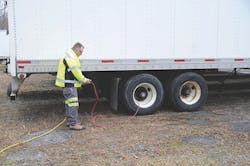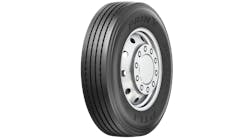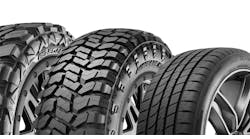During a conference in Europe last year, I had the opportunity to discuss the commercial truck tire business with a tire dealer from Israel. He had some questions about training and what started as a simple inquiry evolved into a chance for both of us to learn more about how truck tires and wheels are serviced in our respective countries.
Among the things that he found fascinating was the role of the service vehicle in North America. Most European road service vehicles are things of beauty with compressors, generators and tire machines. The machines literally fold out to the side so the technician can demount and mount the tire and barely break a sweat. When he learned that service trucks on the other side of the Atlantic still required the technician to do everything by hand (except farm and OTR), he wondered out loud how we could find people to work like that.
The truth is we don’t have much of a choice. Between the number of trucks needed to cover such a large area and the popularity of mounted tire programs, the economics of replacing cargo area with a machine will never add up. Commercial tire dealers need trucks that can deliver and pick up different quantities of tires while simultaneously acting as road service vehicles. It’s a totally different business over here in almost every aspect, so the manual labor component is one that will never be completely erased from the equation.
In order to meet the needs of the largest fleets, dealers have to deliver tires and perform on-site service on a regular basis. Without the versatility of these service trucks, the North American commercial tire business grinds to a halt.Since the trucks serve two purposes, employers must address all of the risks associated with operating a fleet of road service vehicles. Emergency road service presents the greatest degree of risk without a doubt. When an employee is working on the side of a street, road or highway, passing traffic creates a higher level of hazards. That is the primary reason why technicians are advised to park the service truck behind the disabled vehicle. When the service truck is behind the disabled vehicle and the amber beacon and strobe lights are activated, it should be a sign to oncoming traffic that there is an active work zone on the shoulder. I say “should” because I’ve had to dodge my share of right lane drivers who refused to move over and give me space to work. Parking the service truck in front of the disabled vehicle may seem like it shields the technician, but it actually increases the risks because oncoming traffic will not recognize the presence of someone working on what appears to be a truck stopped on the shoulder.
With the service truck safely parked behind the disabled vehicle with the amber beacon and strobe lights activated, the primary danger zone is between the two vehicles. Again, the service truck is not a shield, it’s more like a battering ram. I investigated a fatal accident on an interstate highway a few years ago where the technician was working between the service truck and the disabled vehicle parked directly in front of it. A passing truck hit the back of the service truck and drove it under the trailer, crushing the technician. He never had a chance. Making matters worse was the fact that there was limited shoulder space on that stretch of highway and there was an exit ramp just a few hundred feet ahead. If the disabled truck had literally moved 500 feet forward, the entire accident could have been avoided.
Looking back, there were definitely instances where I should have refused to service the tires unless the vehicle was moved. Road service technicians must be trained to analyze the situation in order to determine if the tires can be serviced safely and if they decide that it’s too dangerous, management must back them when they tell the driver the vehicle has to be moved. There will always be exceptions, but in the case of the accident that I investigated, both tires on the dual were shredded so moving it forward a few hundred feet would not have created any additional costs for the customer.
Even if it does destroy what would be an otherwise repairable tire, it’s not worth someone’s life. Too many unnecessary chances are taken because the technician does not exercise his right to have the driver move the vehicle. Management has to make sure that every road service technician knows they can make that request and if the driver refuses, then it needs to become someone else’s problem.
When faced with moving the truck or sitting on the side of the road for another hour or two waiting for someone else who might make the same request, I want to believe that most drivers will move the truck.
If the technician determines that the tire or tires can be serviced safely, the next step is to ensure visibility. At a minimum, a reflective vest should be worn at all times. More and more commercial tire dealers are incorporating reflective material into pants, shirts and jackets. If you’ve ever seen Matt White with the Tire Industry Association conduct a training class in the field, he takes high visibility to the extreme. I’ve often joked that you could see him from space, but that’s the whole point. Matt knows the dangers of working on the side of the road, in a parking lot or on a job site. High visibility clothing gives him an extra level of protection so most drivers should see him before it’s too late.Another level of visibility is associated with the service truck and the work area. Besides the amber beacon and strobe lights, reflective tape is another effective device for warning oncoming traffic. A few strips of reflective tape on the rear of the service truck are going to make a major difference, especially during dawn, dusk and night-time hours when natural light is minimal or non-existent. Likewise, reflective warning devices must be placed on the shoulder as another warning to oncoming traffic. Technically, the driver should already have them out, but when they are not in place, the technician must take the time to protect himself before attempting to service any tires on the side of a road. Either way, federal law requires the placement of warning devices within 10 minutes of stopping on the shoulder (49 CFR Part 392.22). It needs to be the first thing that is done after a technician steps out of the cab when reflective triangles or warning devices are not in place.
Once the job site is under control, the actual service creates a whole new set of hazards, especially if the tires in need of service are on the driver’s side. Again, if the position of the vehicle creates an unsafe situation in any way, the technician needs to ask the driver to move it to a safer location. I wish I could say contact the state police and ask for traffic control, but I know that such a request has been submitted to every state police department without one return response. It appears that “you’re on your own out there when it comes to tire service unless it’s blocking a lane.” The risk to the technician cannot be understated when working on the side of a road or highway. Even the smallest mistake can be fatal when passing traffic is at highway speed.
The first question that needs to be answered is whether the wheel service creates any hazards. I’ve installed and removed my share of driver’s side truck tires on the side of a highway, so I have firsthand knowledge of the anxiety when you’re holding a 30-pound impact wrench just a few feet from passing traffic. If there isn’t enough room for the driver’s side tires to be serviced safely, then the vehicle has to be moved. We have to change the culture of servicing the tires wherever the vehicle is parked. It can and must be moved if necessary. That same theory applies when there is insufficient room on the passenger’s side. Getting stuck between a concrete retaining wall and a vehicle after it has been struck from behind is not an ideal situation. If the tire(s) needing service is (are) on the right side of the vehicle, there must be enough space to safely work on the wheel end(s).
Consideration must also be given to the location where the demounting, mounting and inflating will occur. Technicians should never work in the kill zone between the stopped vehicle and the service truck. You are blind because you cannot see oncoming traffic and deaf as a result of the engine and compressor noise in that space. In a perfect world, there is sufficient room on the right side of the service truck where the technician can safely service the tire and wheel while still maintaining a line of sight with oncoming traffic.
If there isn’t room to the right of the service truck, then the next safest place would be directly behind the service truck. It all comes down to visibility and line of sight. When working behind the service truck in high visibility clothing, passing motorists are more likely to (hopefully) see the technician and either move over or slow down. If the technician always keeps his back to the service truck when demounting, mounting or inflating the tire(s), then he can more easily see a vehicle drifting onto the shoulder and get out of the way.In the end, it’s a total judgment call for the technician on the side of the road. Did the technician know what to look for? Did the technician understand the risks of servicing a tire in that position on that particular stretch of highway? Do they know the industry best practices for assessing a job site on the side of the road? Did they even have the option of moving the vehicle? A lot of questions get asked after there is an accident. The bottom line will eventually be whether or not it was preventable. Either way, it probably involves a serious or fatal injury so the human cost can never be understated. The best decisions are made when all of the factors have been considered. Road service technicians must be trained to recognize the hazards before they result in an accident and then take the appropriate steps to protect themselves and passing motorists.
In part two of this article, we will look into hazards associated with the greatest risk of emergency road service — actually driving a company service truck! ■
Kevin Rohlwing is the Tire Industry Association’s senior vice president of training.



